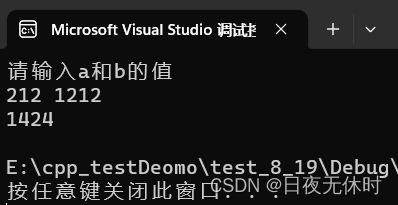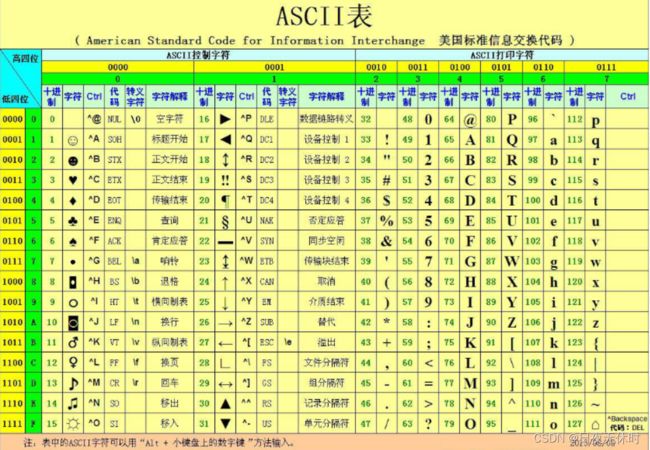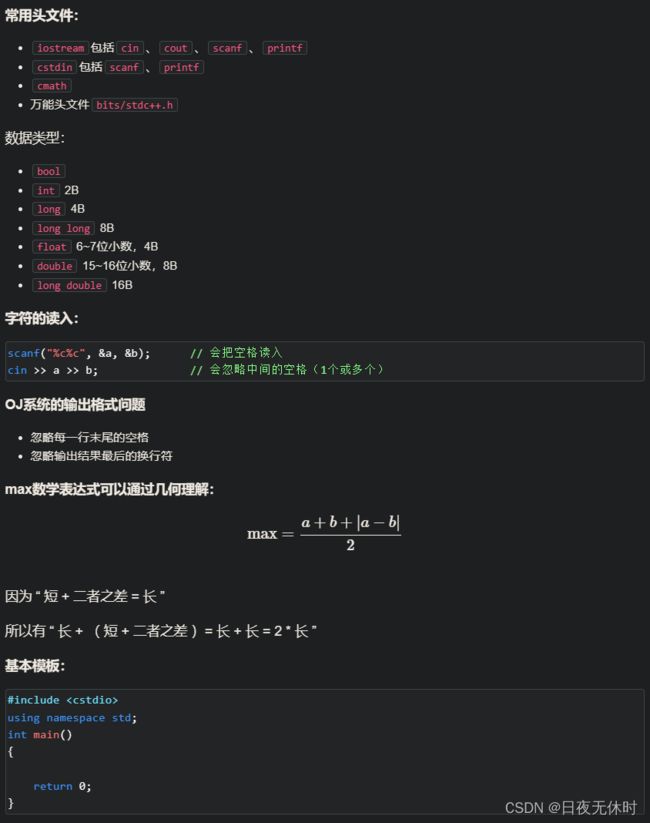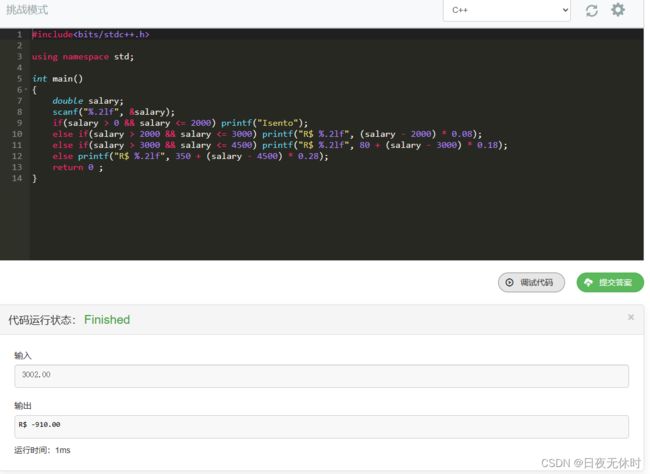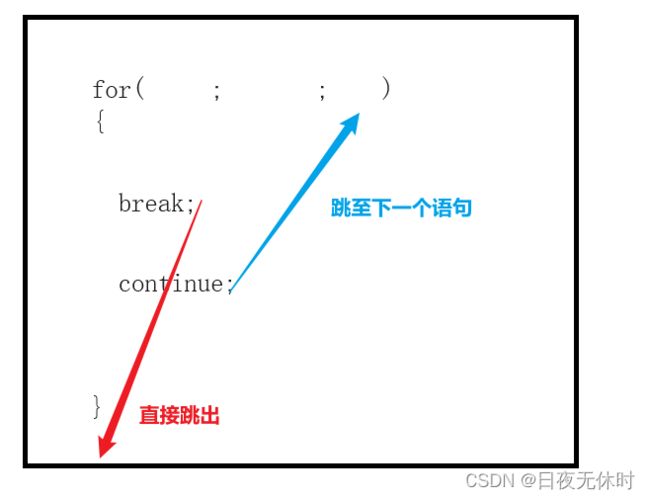【C++】基础语法(上)
C++基础语法
此语法笔记面向算法竞赛考研,可供参考,本人的一些笔记的记录~
失踪人口回归,将近半个月没有更新,那么接下来也会逐步开始更新分享知识内容~
本篇将分享cpp基础语法中的变量、输出输入语句、表达式、顺序语句、条件判断、循环
接下来将会保持定时定量的更新~敬请期待
文章目录
- C++基础语法
-
- 失踪人口回归,将近半个月没有更新,那么接下来也会逐步开始更新分享知识内容~
- 01 变量、输入输出、表达式、顺序语句
-
- 主体结构
- 常用头文件
- 变量
-
- 输入输出
-
- 字符的读入
- 字符的输出
- a+b问题
- 表达式
-
- abs 函数
- 变量的强制类型转换
- 笔记
- 浮点数的比较运算
- 02 判断语句
-
- 从未注意到的点
- 笔记
- 03 循环语句
-
- 斐波那契
- do while
- for循环
- break和continue
- 判断质数
- 输出1-100的偶数和
- 多层循环
- 曼哈顿距离
- 练习
-
- 偶数
- 奇数
- 正数
- 连续奇数的和①
- 递增序列
- 完全数
01 变量、输入输出、表达式、顺序语句
主体结构
// 框架
#include 最简单的C++程序:
//头文件
#include 常用头文件
iostream包括cin、cout、scanf、printf
cstdin包括scanf、printf、cmath
万能头文件bits/stdc++.h
变量
变量先定义才能使用。
#include #include 输入输出
字符的读入
scanf("%c%c", &a, &b); // 会把空格读入
cin >> a >> b; // 会忽略中间的空格(1个或多个)
字符的输出
printf();
cout << << endl;
a+b问题
#include#include
#include
using namespace std;
int main()
{
int a, b;
scanf("%d %d", &a, &b);
printf("两数的和为:%d", a + b);
return 0;
}
在算法中,在所有能用cin cout,都可以使用scanf printf ,但是反之就不一定可以了,前者的效率会低于后者。所以建议使用后者。
注意:使用printf时最好添加头文件#include 。
/*
int %d
float %f
char %c
double %lf
long long %lld
*/
这里有个点:
#includescanf 和 cin 的区别
注意:scanf 是不会自动过滤掉空格 和回车的 \n 的。
表达式
+ - * / %
#include#include-= += /= *= %=
abs 函数
求两数的最大值,公式:
m a x ( a , b ) = [ a + b + a b s ( a − b ) 2 ] max(a,b)= [\frac{a+b+abs(a-b)}{2}] max(a,b)=[2a+b+abs(a−b)]
也就是:
m a x = [ a + b + ∣ a − b ∣ 2 ] max = [\frac {a + b + |a - b|}{2}] max=[2a+b+∣a−b∣]
因为 “ 短 + 二者之差 = 长 ”
所以有 “ 长 + ( 短 + 二者之差 )= 长 + 长 = 2 * 长 ”
变量的强制类型转换
#include
#include
#include
using namespace std;
int main()
{
float x = 123.12;
int y = (int)x;
cout << x << " " << y << endl;
return 0;
}
//输出结果
//123.12 123
笔记
浮点数的比较运算
#include#include02 判断语句
#include#include#define _CRT_SECURE_NO_WARNINGS 1
#include#define _CRT_SECURE_NO_WARNINGS 1
#include#define _CRT_SECURE_NO_WARNINGS 1
#include从未注意到的点
672. 税 - AcWing题库
#include最开始我是
scanf("%.2lf", &salary);
然后在调试阶段就发现问题了
我就开始意识到是.2f的问题,于是翻了一下资料
果然~
-
scanf("%lf", &salary)用于读取一个带有任意小数位数的浮点数。这意味着用户可以输入类似3000.2、3000.25或3000.254等值。因此,当输入3000.2时,程序会执行else if(salary > 2000 && salary <= 3000)这个条件分支。 -
scanf("%.2lf", &salary)的格式化字符串%.2lf会截断输入的小数位数为两位。所以,不论用户输入的小数位数是多少,都会截断为两位小数。当输入3000.2时,实际上salary的值被截断为3000.00,而不是期望的3000.20。因此,程序会执行else if(salary > 3000 && salary <= 4500)这个分支。
这就是两个代码示例输出结果不同的原因。
总结起来,使用 scanf("%lf", &salary) 可以读取任意位数的小数值,而使用 scanf("%.2lf", &salary) 则只读取两位小数的值,并截断输入的其他小数位。
笔记
03 循环语句
斐波那契
f(1) = 1 f(2) = 1
n>=3 f(n) = f(n-1) + f(n-2)
#include注意死循环!循环永久进行,无法结束
do while
使用很少,无论条件的值是什么,至少执行一次
先上车,再买票的feel~
#includefor循环
for(int 语句; 条件语句; 表达式)
{
}
break和continue
判断质数
条件:n>=2,因数只有它本身和1
#include输出1-100的偶数和
#include多层循环
曼哈顿距离
d i s t = ∣ x 1 − x 2 ∣ + ∣ y 1 − y 2 ∣ dist = |x1 - x2|+|y1-y2| dist=∣x1−x2∣+∣y1−y2∣
用曼哈顿距离解决菱形输出问题:
曼哈顿距离指的是两个点在标准坐标系上的绝对轴距离之和
输出 n = 5 n=5 n=5 的菱形矩阵,分析如下:
( 4 3 2 3 4 3 2 1 2 3 2 1 0 1 2 3 2 1 2 3 4 3 2 3 4 ) \left(\begin {array}{c} 4 &3 &2 &3 & 4 \\ 3 &2 &1 &2 &3 \\ 2 &1 &0 &1 &2 \\ 3 &2 &1 &2 &3 \\ 4 &3 &2 &3 & 4 \\ \end{array}\right) 4323432123210123212343234
若在元素值 <=代码: n 2 \frac{n}{2} 2n输出*, > n 2 \frac{n}{2} 2n输出空格即可
#include想要空心的效果就将if(abs(i - cx) + abs(j - cy) <= n / 2)判断条件换成==就好了。
练习
偶数
编写一个程序,输出 11 到 100100 之间(包括 11 和 100100)的全部偶数。
输入格式
无输入。
输出格式
输出全部偶数,每个偶数占一行。
输入样例
No input
输出样例
2
4
6
...
100
#include奇数
#include正数
输入 66 个实数,它们要么是正数,要么是负数。
请你统计并输出正数的个数。
输入格式
六个数字,每个占一行。
输出格式
输出格式为 x positive numbers,其中 x为正数的个数。
数据范围
输入数字的绝对值不超过 100100。
输入样例:
7
-5
6
-3.4
4.6
12
输出样例:
4 positive numbers
#include连续奇数的和①
给定两个整数 X和 Y,输出在他们之间(不包括 X和 Y)的所有奇数的和。
输入格式
第一行输入 X,第二行输入 Y。
输出格式
输出一个整数,表示所有满足条件的奇数的和。
数据范围
−100≤X,Y≤100−100≤x,Y≤100
输入样例1:
6
-5
输出样例1:
5
输入样例2:
15
12
输出样例2:
13
输入样例3:
12
12
输出样例3:
0
#include递增序列
//第一种输入方式
#include 完全数
一个整数,除了本身以外的其他所有约数的和如果等于该数,那么我们就称这个整数为完全数。
例如,66 就是一个完全数,因为它的除了本身以外的其他约数的和为 1+2+3=61+2+3=6。
现在,给定你 N个整数,请你依次判断这些数是否是完全数。
输入格式
第一行包含整数 N,表示共有 N 个测试用例。
接下来 N行,每行包含一个需要你进行判断的整数 X。
输出格式
每个测试用例输出一个结果,每个结果占一行。
如果测试数据是完全数,则输出 X is perfect,其中 X 是测试数据。
如果测试数据不是完全数,则输出 X is not perfect,其中 X是测试数据。
输入样例:
3
6
5
28
输出样例:
6 is perfect
5 is not perfect
28 is perfect
#include不幸的是,这样超时了,有时间限制。
为了提高效率,可以对算法进行一些优化,减少不必要的因子计算。一个常见的优化是只计算 x 的一半(包括1),然后将因子对应地相加。这可以减少循环次数,提高效率。
以下是优化后的代码示例:
#include 这个优化后的代码应该更加高效,减少了因子的计算次数。它先计算 x 的平方根以下的因子,再根据对称性计算其它因子。这种优化应该能够显著减少运行时间,避免超时。
726. 质数 - AcWing题库
#include